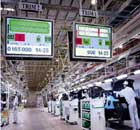Editorials
Four million headaches
(China Daily)
Updated: 2009-12-18 07:53
 |
Large Medium Small |
The Beijing municipal government must pride itself on rocketing car ownership, a symbol of both the city's prosperity and profits for carmakers.
However, if local officials still have no concerns about worsening traffic conditions as the city's car population continues to soar, the double whammy of disastrous air pollution and unbearable congestion is just around the corner.
The city's car population reached 3.99 million last Sunday. Given the eagerness of local car buyers and dealers to cut last-minute deals before the vehicle purchase tax for low-emission cars is raised from 5 percent this year to 7.5 percent from Jan 1 next year, it is very likely that Beijing's car ownership will cross the threshold of 4 million by this weekend.
| ||||
But the increase of the city's car population in terms of absolute numbers is definitely formidable. It took six years for car ownership to rise from 1 million to 2 million by 2003, another four years to reach 3 million by 2007 and now just two years to hit 4 million.

The increasingly steep growth curve of car ownership tells a lot about the potential and prosperity of the city's economy. And it is more than welcome at the moment given that Chinese policymakers are trying hard to boost domestic consumption to help cushion the economy against the worst global recession in many decades.
Nonetheless, while giving a much-needed lift to local economic growth, the car rush also brings with it enormous side effects that urban planners cannot afford to ignore.
On the one hand, for Beijing, which had gone all out to increase the number of blue sky days before hosting the Olympic Games in 2008, the impact of cars on its air quality is becoming increasingly unbearable. It is estimated that the 4 million cars will emit 1 million tons of pollutants each year, accounting for half of the city's total emissions.
On the other, the car rush that has been running out of control will only add to the slow but steady deterioration of traffic conditions. Though local officials have come up with some measures to limit the number of cars on roads, their efforts have only been inching at a glacial pace compared with the growth of car ownership.
There are many useful experiences that Beijing's municipal authorities can learn from other international cities on how to manage traffic even with a big car population.
The 4 million cars do not have to be a recipe for urban planners' nightmare if they can discourage driving in downtown areas, such as by imposing a congestion tax, while investing more to improve public transport.
(China Daily 12/18/2009 page8)












